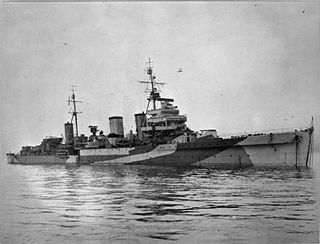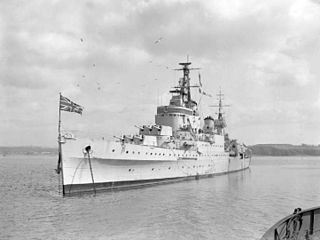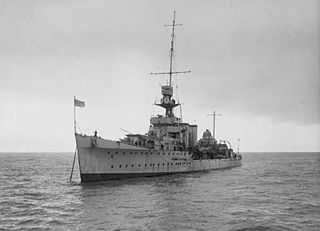
HMS Enterprise was one of two Emerald-class light cruisers built for the Royal Navy. She was built by John Brown & Company, with the keel being laid down on 28 June 1918. She was launched on 23 December 1919, and commissioned on 7 April 1926. She was the 14th ship to serve with the Royal Navy to carry the name Enterprise, a name which is still used in the Royal Navy today.

The seventh HMS Newcastle was a member of the Southampton subclass of the Town-class light cruiser of the Royal Navy.

The Home Fleet was a fleet of the Royal Navy that operated from the United Kingdom's territorial waters from 1902 with intervals until 1967. In 1967, it was merged with the Mediterranean Fleet creating the new Western Fleet.

HMS Euryalus was a Dido-class cruiser of the Royal Navy. She was laid down at Chatham Dockyard on 21 October 1937, launched on 6 June 1939, and commissioned 30 June 1941. Euryalus was the last cruiser built at the dockyard.

HMS Phoebe was a Dido-class light cruiser of the Royal Navy. She was built by Fairfield Shipbuilding and Engineering Company, her keel was laid down on 2 September 1937. She was launched on 25 March 1939, and commissioned on 30 September 1940.

HMS Dido was the name ship of her class of light cruisers for the Royal Navy. Constructed by Cammell Laird Shipyard of Birkenhead, United Kingdom, she entered service in 1940 during World War II. The cruiser took part in several battles in the Mediterranean and Arctic theatres of war. Following the war, the ship performed ceremonial functions before being sold for scrapping in 1957.

Operation Inmate was an attack by the British Pacific Fleet against Japanese positions on Truk Atoll in the central Pacific Ocean during the Second World War. The attacks against the isolated islands on 14 and 15 June 1945 were conducted to provide combat experience for the aircraft carrier HMS Implacable and several of the fleet's cruisers and destroyers ahead of their involvement in more demanding operations off the Japanese home islands.

HMS Royalist was a Bellona-class light cruiser of the Royal Navy (RN) during the Second World War.

HMS Delhi was a Danae-class cruiser that served with the Royal Navy through the Second World War, from the Caribbean to eastern China. She was laid down in 1917, launched in 1918 and commissioned for service in 1919, serving until decommissioning in mid-1945 due to extensive battle damage, and was to be scrapped in 1948 after lengthy war and peacetime service around the world.

HMS Calcutta was a C-class light cruiser of the Royal Navy, named after the Indian city of Calcutta. She was part of the Carlisle group of the C class of cruisers. She was laid down by Vickers Limited at Barrow-in-Furness in 1917 and launched on 9 July 1918. Calcutta was commissioned too late to see action in the First World War and was converted to an anti-aircraft cruiser in 1939. Calcutta served during the Norwegian Campaign and the evacuation from Dunkirk in 1940. She was used to escort allied convoys across the Mediterranean and was sunk on 1 June 1941 by Luftwaffe aircraft off Alexandria, Egypt.
The 3rd Battle Squadron was a naval squadron of the British Royal Navy consisting of battleships and other vessels, active from at least 1914 to 1945. The 3rd Battle Squadron was initially part of the Royal Navy's Home Fleet. During the First World War, the Home Fleet was renamed the Grand Fleet. During the Second World War, the squadron covered Atlantic convoys.

The 1st Aircraft Carrier Squadron was a formation of Royal Navy aircraft carriers assigned to the British Pacific Fleet in November 1943. They were: HMS Formidable, HMS Indomitable, HMS Victorious, HMS Illustrious and HMS Indefatigable. It was disbanded in 1947.

The Eastern Fleet, later called the East Indies Fleet, was a fleet of the Royal Navy which existed between 1941 and 1952.

The 5th Cruiser Squadron and also known as Cruiser Force D was a formation of cruisers of the British Royal Navy from 1907 to 1915 and then again from 1939 to 1946.

The British 3rd Aircraft Carrier Squadron also called Third Aircraft Carrier Squadron was a military formation of Aircraft Carriers of the Royal Navy from January 1948 to July 1952.

The British 11th Aircraft Carrier Squadron also called Eleventh Aircraft Carrier Squadron was a military formation of aircraft carriers of the Royal Navy from 1 March 1945 to December 1945.

The Red Sea Station was a military formation of the Royal Navy. At various times it has also been referred to as Egypt Division and Red Sea and later the Red Sea and Canal Area. The Royal Navy had distinct formations for the Red Sea at intervals from 1846 until circa 1944-45.

Operation Stab was a British naval deception during the Second World War to distract Japanese units for the upcoming Guadalcanal campaign by US forces.













